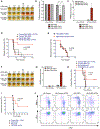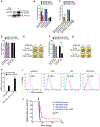The histone demethylase PHF8 governs retinoic acid response in acute promyelocytic leukemia
- PMID: 23518351
- PMCID: PMC6812572
- DOI: 10.1016/j.ccr.2013.02.014
The histone demethylase PHF8 governs retinoic acid response in acute promyelocytic leukemia
Abstract
While all-trans retinoic acid (ATRA) treatment in acute promyelocytic leukemia (APL) has been the paradigm of targeted therapy for oncogenic transcription factors, the underlying mechanisms remain largely unknown, and a significant number of patients still relapse and become ATRA resistant. We identified the histone demethylase PHF8 as a coactivator that is specifically recruited by RARα fusions to activate expression of their downstream targets upon ATRA treatment. Forced expression of PHF8 resensitizes ATRA-resistant APL cells, whereas its downregulation confers resistance. ATRA sensitivity depends on the enzymatic activity and phosphorylation status of PHF8, which can be pharmacologically manipulated to resurrect ATRA sensitivity to resistant cells. These findings provide important molecular insights into ATRA response and a promising avenue for overcoming ATRA resistance.
Copyright © 2013 Elsevier Inc. All rights reserved.
Figures







Similar articles
-
Reduced retinoic acid-sensitivities of nuclear receptor corepressor binding to PML- and PLZF-RARalpha underlie molecular pathogenesis and treatment of acute promyelocytic leukemia.Blood. 1998 Apr 15;91(8):2634-42. Blood. 1998. PMID: 9531570
-
Interactions of STAT5b-RARalpha, a novel acute promyelocytic leukemia fusion protein, with retinoic acid receptor and STAT3 signaling pathways.Blood. 2002 Apr 15;99(8):2637-46. doi: 10.1182/blood.v99.8.2637. Blood. 2002. PMID: 11929748
-
Knockdown of SALL4 Protein Enhances All-trans Retinoic Acid-induced Cellular Differentiation in Acute Myeloid Leukemia Cells.J Biol Chem. 2015 Apr 24;290(17):10599-609. doi: 10.1074/jbc.M114.634790. Epub 2015 Mar 3. J Biol Chem. 2015. PMID: 25737450 Free PMC article.
-
Transcription therapy for acute promyelocytic leukaemia.Expert Opin Investig Drugs. 2000 Feb;9(2):329-46. doi: 10.1517/13543784.9.2.329. Expert Opin Investig Drugs. 2000. PMID: 11060680 Review.
-
The molecular biology of acute promyelocytic leukemia.Cancer Treat Res. 1999;99:75-124. doi: 10.1007/978-0-585-38571-6_4. Cancer Treat Res. 1999. PMID: 9891864 Review.
Cited by
-
RNAi screen identifies Jarid1b as a major regulator of mouse HSC activity.Blood. 2013 Aug 29;122(9):1545-55. doi: 10.1182/blood-2013-04-496281. Epub 2013 Jun 18. Blood. 2013. PMID: 23777767 Free PMC article.
-
Retinoic acid and arsenic trioxide induce lasting differentiation and demethylation of target genes in APL cells.Sci Rep. 2019 Jul 1;9(1):9414. doi: 10.1038/s41598-019-45982-7. Sci Rep. 2019. PMID: 31263158 Free PMC article.
-
Regression analysis of combined gene expression regulation in acute myeloid leukemia.PLoS Comput Biol. 2014 Oct 23;10(10):e1003908. doi: 10.1371/journal.pcbi.1003908. eCollection 2014 Oct. PLoS Comput Biol. 2014. PMID: 25340776 Free PMC article.
-
Histone demethylase PHF8 promotes epithelial to mesenchymal transition and breast tumorigenesis.Nucleic Acids Res. 2017 Feb 28;45(4):1687-1702. doi: 10.1093/nar/gkw1093. Nucleic Acids Res. 2017. PMID: 27899639 Free PMC article.
-
RNA-Guided CRISPR-Cas9 System-Mediated Engineering of Acute Myeloid Leukemia Mutations.Mol Ther Nucleic Acids. 2017 Mar 17;6:243-248. doi: 10.1016/j.omtn.2016.12.012. Epub 2017 Jan 12. Mol Ther Nucleic Acids. 2017. PMID: 28325290 Free PMC article.
References
-
- Arrowsmith CH, Bountra C, Fish PV, Lee K, and Schapira M (2012). Epigenetic protein families: a new frontier for drug discovery. Nat. Rev. Drug Discov 11, 384–400. - PubMed
-
- Cheung N, and So CW (2011). Transcriptional and epigenetic networks in haematological malignancy. FEBS Lett. 585, 2100–2111. - PubMed
-
- Côté S, Zhou D, Bianchini A, Nervi C, Gallagher RE, and Miller WH Jr. (2000). Altered ligand binding and transcriptional regulation by mutations in the PML/RARalpha ligand-binding domain arising in retinoic acid-resistant patients with acute promyelocytic leukemia. Blood 96, 3200–3208. - PubMed
Publication types
MeSH terms
Substances
Grants and funding
LinkOut - more resources
Full Text Sources
Other Literature Sources
Molecular Biology Databases

